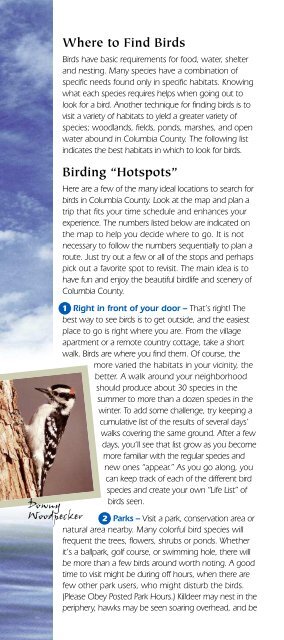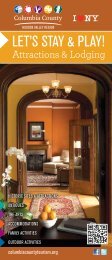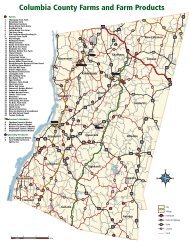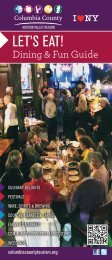BIRD GUIDE - Columbia County Tourism
BIRD GUIDE - Columbia County Tourism
BIRD GUIDE - Columbia County Tourism
You also want an ePaper? Increase the reach of your titles
YUMPU automatically turns print PDFs into web optimized ePapers that Google loves.
Downy<br />
Woodpecker<br />
Where to Find Birds<br />
Birds have basic requirements for food, water, shelter<br />
and nesting. Many species have a combination of<br />
specific needs found only in specific habitats. Knowing<br />
what each species requires helps when going out to<br />
look for a bird. Another technique for finding birds is to<br />
visit a variety of habitats to yield a greater variety of<br />
species; woodlands, fields, ponds, marshes, and open<br />
water abound in <strong>Columbia</strong> <strong>County</strong>. The following list<br />
indicates the best habitats in which to look for birds.<br />
Birding “Hotspots”<br />
Here are a few of the many ideal locations to search for<br />
birds in <strong>Columbia</strong> <strong>County</strong>. Look at the map and plan a<br />
trip that fits your time schedule and enhances your<br />
experience. The numbers listed below are indicated on<br />
the map to help you decide where to go. It is not<br />
necessary to follow the numbers sequentially to plan a<br />
route. Just try out a few or all of the stops and perhaps<br />
pick out a favorite spot to revisit. The main idea is to<br />
have fun and enjoy the beautiful birdlife and scenery of<br />
<strong>Columbia</strong> <strong>County</strong>.<br />
1 Right in front of your door – That’s right! The<br />
best way to see birds is to get outside, and the easiest<br />
place to go is right where you are. From the village<br />
apartment or a remote country cottage, take a short<br />
walk. Birds are where you find them. Of course, the<br />
more varied the habitats in your vicinity, the<br />
better. A walk around your neighborhood<br />
should produce about 30 species in the<br />
summer to more than a dozen species in the<br />
winter. To add some challenge, try keeping a<br />
cumulative list of the results of several days’<br />
walks covering the same ground. After a few<br />
days, you‘ll see that list grow as you become<br />
more familiar with the regular species and<br />
new ones “appear.” As you go along, you<br />
can keep track of each of the different bird<br />
species and create your own “Life List” of<br />
birds seen.<br />
2 Parks – Visit a park, conservation area or<br />
natural area nearby. Many colorful bird species will<br />
frequent the trees, flowers, shrubs or ponds. Whether<br />
it’s a ballpark, golf course, or swimming hole, there will<br />
be more than a few birds around worth noting. A good<br />
time to visit might be during off hours, when there are<br />
few other park users, who might disturb the birds.<br />
(Please Obey Posted Park Hours.) Killdeer may nest in the<br />
periphery, hawks may be seen soaring overhead, and be<br />
sure to watch for flycatchers in the outfield or an eagle at the<br />
thirteenth hole.<br />
3 Clermont State Historic Site –<br />
Originally the home of one of New York’s<br />
earliest and most prominent families,<br />
visitors enjoy this Hudson River Estate’s<br />
grand architecture, landscapes, gardens<br />
and collections. In addition to good views<br />
of the river, this site offers several trails that<br />
attract many migrating songbirds. Scan<br />
the river in fall and winter for large flocks<br />
of migrant geese and ducks. In the<br />
spring, listen and watch for Magnolia Warblers,<br />
Black-throated Green Warblers, and Blackthroated<br />
Blue Warblers as they search for<br />
insects to fuel them forward on their journey to nesting<br />
sites in the Adirondacks and nearby. In summer, listen for the<br />
Baltimore<br />
Oriole<br />
scratching sounds of Eastern Towhees and Ovenbirds searching<br />
for food among the oak and maple leaves of the shaded<br />
woodland floor. You can hear the song of the Ovenbird well into<br />
late summer, after many of our other songbirds have left and<br />
flown south. Listen for its sound, loudest just before the<br />
kids head back to school. Call the Clermont office for a current<br />
schedule of monthly guided bird walks, 518-537-4240.<br />
4 Ernest R. Lasher Memorial Park at the Germantown<br />
Boat Launch – This spot is excellent for watching resident<br />
and migrating waterfowl. Duck counts have recorded dozens<br />
of Gadwall, Greater and Lesser Scaup, Canvasback, Northern<br />
Pintail, Common Mergansers and hundreds of Mallards, American<br />
Black Ducks, and Canada Geese. Rare winter visitors include<br />
Tundra Swan, Long-tailed Duck, and Barrow’s Goldeneye.<br />
5 Olana State Historic Site – This site is the former estate of<br />
Hudson River School painter Frederic Church, one of New York<br />
State‘s most famous 19th-century painters. It has many popular<br />
wooded trails that attract several species of woodpeckers,<br />
vireos, warblers, and sparrows. Watch out for Scarlet Tanagers in<br />
the canopy overhead and listen for the relentless spring song of<br />
the Red-eyed Vireo, aptly nicknamed the “Preacher Bird.” The<br />
crow-sized Pileated Woodpecker has been known to breed<br />
here, nesting in tree cavities that it excavates with its daggershaped<br />
bill. After a morning walk, bring a picnic lunch to eat<br />
on the large hilltop overlooking the magnificent view of the<br />
Hudson River and Catskills – a scene immortalized in watercolors<br />
and oils by Church. Keep your binoculars close by in<br />
case a hawk or falcon flies over.<br />
6 Hudson Boat Launch – Visit any time of year and scan<br />
the water and island for Great Blue Herons, Great Egrets, Wood<br />
Ducks, Osprey, Belted Kingfishers, Fish Crows and Bank





